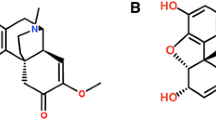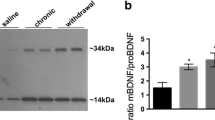Abstract
The effects of acute and chronic morphine treatments on the expression of Ca2+/calmodulin dependent protein kinase II (CaMK II) gene in rat brain were investigated using in situ hybridization histochemistry. Our data showed that repeated, but not single morphine administration, resulted in significant up-regulation of the α-CaMK II gene expression in hippocampus and frontal cortex. We further studied the time courses of α-CaMK II gene expression in response to repeated morphine administration. After 3 days of consecutive morphine injections, the α-CaMK II mRNA levels exhibited a trend of up-regulation, and after 6 days of consecutive morphine injections it increased over 50–60% as compared with the control group. The α-CaMK II mRNA levels remained high 24 h after the cessation of chronic morphine treatment and returned to the control level 72 h later. However, changes of α-CaMK II gene levels mentioned above were not detected in amygdala or piriform cortex. Taken together, our data demonstrate that chronic morphine treatment region-specific up-regulates the levels of the α-CaMK II gene expression in hippocampus and frontal cortex.



Similar content being viewed by others
References
Narita M, Funada M, Suzuki T (2001) Regulations of opioid dependence by opioid receptor types. Pharmacol Ther 89(1):1–15
Kieffer BL, Gaveriaux-Ruff C (2002) Exploring the opioid system by gene knockout. Prog Neurobiol 66(5):285–306
Nestler EJ (2004) Historical review: molecular and cellular mechanisms of opiate and cocaine addiction. Trends Pharmacol Sci 25(4):210–218
Kreek MJ (2001) Drug addictions. Molecular and cellular endpoints. Ann N Y Acad Sci 937:27–49
Nestler EJ (1997) Molecular mechanisms of opiate and cocaine addiction. Curr Opin Neurobiol 7(5):713–719
McClung CA, Nestler EJ (2008) Neuroplasticity mediated by altered gene expression. Neuropsychopharmacology 33(1):3–17
Robinson TE, Kolb B (2004) Structural plasticity associated with exposure to drugs of abuse. Neuropharmacology 47(Suppl 1):33–46
Hudmon A, Schulman H (2002) Structure–function of the multifunctional Ca2+/calmodulin-dependent protein kinase II. Biochem J 364(Pt 3):593–611
Yamauchi T (2005) Neuronal Ca2+/calmodulin-dependent protein kinase II—discovery, progress in a quarter of a century, and perspective: implication for learning and memory. Biol Pharm Bull 28(8):1342–1354
Wickelgren I (1998) Teaching the brain to take drugs. Science 280(5372):2045–2046
Marek P, Ben-Eliyahu S, Gold M, Liebeskind JC (1991) Excitatory amino acid antagonists (kynurenic acid and MK-801) attenuate the development of morphine tolerance in the rat. Brain Res 547(1):77–81
Trujillo KA, Akil H (1991) Inhibition of morphine tolerance and dependence by the NMDA receptor antagonist MK-801. Science 251(4989):85–87
Hamdy MM, Noda Y, Miyazaki M, Mamiya T, Nozaki A, Nitta A, Sayed M, Assi AA, Gomaa A, Nabeshima T (2004) Molecular mechanisms in dizocilpine-induced attenuation of development of morphine dependence: an association with cortical Ca2+/calmodulin-dependent signal cascade. Behav Brain Res 152(2):263–270
Silva AJ, Paylor R, Wehner JM, Tonegawa S (1992) Impaired spatial learning in alpha-calcium-calmodulin kinase II mutant mice. Science 257(5067):206–211
Lisman J (1994) The CaM kinase II hypothesis for the storage of synaptic memory. Trends Neurosci 17(10):406–412
Wolfman C, Fin C, Dias M, Bianchin M, Da Silva RC, Schmitz PK, Medina JH, Izquierdo I (1994) Intrahippocampal or intraamygdala infusion of KN62, a specific inhibitor of calcium/calmodulin-dependent protein kinase II, causes retrograde amnesia in the rat. Behav Neural Biol 61(3):203–205
Lou L, Zhou T, Wang P, Pei G (1999) Modulation of Ca2+/calmodulin-dependent protein kinase II activity by acute and chronic morphine administration in rat hippocampus: differential regulation of alpha and beta isoforms. Mol Pharmacol 55(3):557–563
Fan GH, Wang LZ, Qiu HC, Ma L, Pei G (1999) Inhibition of calcium/calmodulin-dependent protein kinase II in rat hippocampus attenuates morphine tolerance and dependence. Mol Pharmacol 56(1):39–45
Lu L, Zeng S, Liu D, Ceng X (2000) Inhibition of the amygdala and hippocampal calcium/calmodulin-dependent protein kinase II attenuates the dependence and relapse to morphine differently in rats. Neurosci Lett 291(3):191–195
Landry M, Roche D, Angelova E, Calas A (1997) Expression of galanin in hypothalamic magnocellular neurones of lactating rats: co-existence with vasopressin and oxytocin. J Endocrinol 155(3):467–481
Burgin KE, Waxham MN, Rickling S, Westgate SA, Mobley WC, Kelly PT (1990) In situ hybridization histochemistry of Ca2+/calmodulin-dependent protein kinase in developing rat brain. J Neurosci 10(6):1788–1798
Ouimet CC, McGuinness TL, Greengard P (1984) Immunocytochemical localization of calcium/calmodulin-dependent protein kinase II in rat brain. Proc Natl Acad Sci USA 81(17):5604–5608
Boehm J, Malinow R (2005) AMPA receptor phosphorylation during synaptic plasticity. Biochem Soc Trans 33(Pt 6):1354–1356
Anderson SM, Famous KR, Sadri-Vakili G, Kumaresan V, Schmidt HD, Bass CE, Terwilliger EF, Cha JH, Pierce RC (2008) CaMKII: a biochemical bridge linking accumbens dopamine and glutamate systems in cocaine seeking. Nat Neurosci 11:344–353
Ahmed BY, Yamaguchi F, Tsumura T, Gotoh T, Sugimoto K, Tai Y, Konishi R, Kobayashi R, Tokuda M (2000) Expression and subcellular localization of multifunctional calmodulin-dependent protein kinases-I, -II and -IV are altered in rat hippocampal CA1 neurons after induction of long-term potentiation. Neurosci Lett 290(2):149–153
Nestler EJ (2001) Molecular neurobiology of addiction. Am J Addict 10(3):201–217
Silva AJ, Stevens CF, Tonegawa S, Wang Y (1992) Deficient hippocampal long-term potentiation in alpha-calcium-calmodulin kinase II mutant mice. Science 257(5067):201–206
Tan SE, Liang KC (1997) Inhibitory avoidance learning alters the amygdala calcium/calmodulin-dependent protein kinase II activity in rats. Brain Res 748(1–2):227–233
Liang D, Li X, Clark JD (2004) Increased expression of Ca2+/calmodulin-dependent protein kinase II alpha during chronic morphine exposure. Neuroscience 123(3):769–775
Blitzer RD, Connor JH, Brown GP, Wong T, Shenolikar S, Iyengar R, Landau EM (1998) Gating of CaMKII by cAMP-regulated protein phosphatase activity during LTP. Science 280(5371):1940–1942
Tsankova N, Renthal W, Kumar A, Nestler EJ (2007) Epigenetic regulation in psychiatric disorders. Nat Rev Neurosci 8(5):355–367
Kumar A, Choi KH, Renthal W, Tsankova NM, Theobald DE, Truong HT, Russo SJ, Laplant Q, Sasaki TS, Whistler KN, Neve RL, Self DW, Nestler EJ (2005) Chromatin remodeling is a key mechanism underlying cocaine-induced plasticity in striatum. Neuron 48(2):303–314
Acknowledgments
We thank Shiduo Lu, Renhao Xue, Yan Liu, Yuqiu Zhang, Yanqing Wang, and Xiu Gao for their technical help. This work was supported in part by grants from the Ministries of Science and Technology and Education (2003CB515405/2005CB522406/PCSIRT), and Shanghai Municipal Commissions for Science and Technology and Education (06JC14008/SLADP B119).
Author information
Authors and Affiliations
Corresponding author
Additional information
Special issue in honor of Dr. Ji-Sheng Han.
Yuejun Chen, Yan Jiang, Wen Yue contributed equally to this work.
Rights and permissions
About this article
Cite this article
Chen, Y., Jiang, Y., Yue, W. et al. Chronic, but Not Acute Morphine Treatment, Up-regulates α-Ca2+/calmodulin Dependent Protein Kinase II Gene Expression in Rat Brain. Neurochem Res 33, 2092–2098 (2008). https://doi.org/10.1007/s11064-008-9690-0
Received:
Accepted:
Published:
Issue Date:
DOI: https://doi.org/10.1007/s11064-008-9690-0




